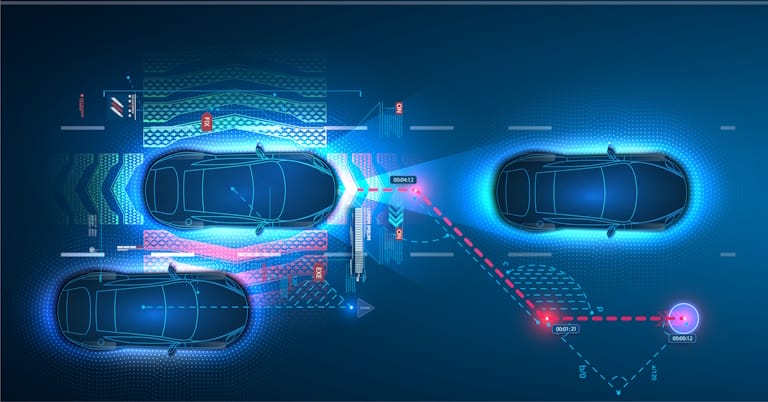

Quartz-Based Electronic Components Drive This Wide-Reaching Market
The transportation industry continues to evolve, bringing cutting-edge products to market that change the way people and goods navigate the world.
The future of transportation will include advanced electric vehicles with innovative driving, safety and infotainment features than we can currently comprehend.
The demand for micro-mobility, including e-bikes and scooters, is a growing market that also addresses carbon emissions, the fast delivery of goods and services and overcrowding.
Air traffic control, fleet management and logistics, public transportation and tolling systems are also applying new technologies to make our daily lives safer and more efficient.
The transportation market provides many opportunities for designers to think big. However, no matter what subsector an engineer builds for, one key force keeps this industry running: frequency.
How Timing Solutions Deliver for the Transportation Industry
On any circuit board, engineers rely on timing circuits to perform three vital functions:
- Communication
- Synchronization
- Orchestration of tasks
Although these functions are vital to the performance of electronics in nearly every market segment, the transportation industry is particularly reliant on them for large and small use cases.
First and foremost, the electrification and technification of modern vehicles requires the backing of exceptional electronic components. Timing solutions ensure that the complexity and sophistication of the following applications succeed:
- Infotainment
- Navigation
- Tire pressure monitoring
- Telematics
- Advanced Driving Assistant System (ADAS)
- Camera Systems
- Vehicle-to-everything (V2X)
- And many others.
To dive a bit deeper into these applications, infotainment systems keep human time, send device-to-device signals and provide an exceptional user experience, so the driver can benefit from all that in-vehicle media has to offer. Timekeeping, communication signals and user-initiated actions are all dependent on high-functioning timing circuits.
Similarly, cameras and sensors in ADAS or functional safety technology process more data than ever before to keep drivers alert and safe on the road. Computer processing requires clocks to deliver a clean signal, so data is interpreted and functions are initiated quite literally in the nick of time.
Timing Solutions for Micro-mobility, Public Transportation, Charging and More
- Timing circuits are essential for any project design in these additional transportation industry segments:
- Micro-mobility: E-bikes and scooters require clocks for Wi-Fi or Bluetooth connectivity, tracking and making payments, sensors for safety (including tire pressure monitoring) and other key functions.
- Public and commercial transportation: Both public and commercial transportation depend on coordination and synchronization to ensure the safe delivery of passengers and physical assets. Among many other use cases, timing circuits are required to maintain precise timing among multiple vehicles, provide real-time information to customers, follow the movement of planes in airspace, track shipping fleets and even activate warning lights, barriers and signals.
- EV charging stations: Clocking signals are essential for many aspects of these products stations, including initiating and monitoring charging. Charging stations’ built-in interfaces that communicate information (e.g., time remaining until fully charged), as well as user-directed prompts, also require timing solutions. The transmission of data regarding how chargers are being used is also dependent on timing, as users seek to analyze their energy impact.
- Payment systems and tolling: Payment and tolling systems require clocks to process data from sensors or cameras, initiate barriers, provide screen information, print tickets, create accurate timestamps and read license plates, among other functions.
How to Find High-Quality Timing Solutions for Your Transportation Project
Although each project for a transportation application requires unique timing circuits, certain qualities position you for exceptional results.
Look for the following product characteristics when seeking out a transportation-specific electronic component manufacturer:
- IATF 16949 certification
- AEC-Q200 qualification
- Extended temperature range
- Small form factor
- Low aging and long-term reliability
- Ruggedization
- Excellent quality factor (‘Q’ factor)
It is also vital that you select a manufacturer with a high level of experience helping designers complete their projects successfully. Look for a manufacturer that offers:
- Samples for prototypes
- Engineering support
- Layout assistance
- Testing
- Optimizations
- Key relationships with chip manufacturers
Your chosen manufacturer should also supply additional solutions that are highly effective for your transportation project, including shielded power inductors, to protect sensitive electronics. This power management solution provides a clean, stable power source, while safeguarding circuitry.
Control your transportation project’s performance by integrating timing circuits and other products, including power inductors, from ECS Inc. A manufacturer whose name is synonymous with frequency, ECS Inc. delivers dependable results with premium components, so you can generate designs that will improve the future of the transportation industry.
Learn more about ECS Inc.’s flagship solutions for automotive projects and more.
The Critical Role of Timing Solutions in the Transportation Industry was last modified: January 12th, 2024 by